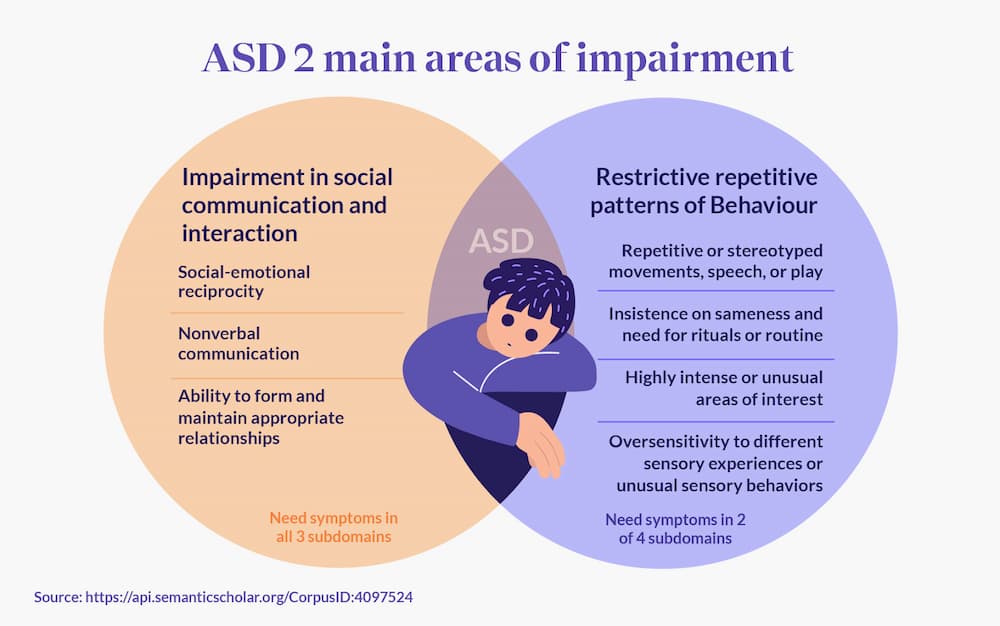Comprehending the Effect of Behavioral Autism on Life and Social Communications
You might not recognize just how deeply behavioral autism influences daily life and social interactions. People on the spectrum commonly navigate a world filled with interaction hurdles and sensory overload. These obstacles can lead to irritation and isolation, influencing their relationships and total well-being.
Specifying Behavioral Autism and Its Features
Behavioral autism, typically referred to as autism spectrum disorder (ASD), encompasses a variety of conditions characterized by challenges in social communication, communication, and repetitive habits. You could discover that people with ASD often have a hard time to analyze social cues, which can lead to misunderstandings in conversations. They might find it difficult to develop eye get in touch with or take part in tiny talk, making social circumstances really feel overwhelming.
Communication troubles can manifest in different means, from delayed speech growth to a preference for making use of less words. Repeated habits, such as hand-flapping or rocking, can serve as coping mechanisms to take care of stress and anxiety or sensory overload. These characteristics can exceptionally affect every day life, making it necessary for you to understand and support those with ASD. By acknowledging these attributes, you can cultivate an environment that promotes acceptance and encourages effective communication, assisting individuals with autism prosper in their everyday communications.
The Spectrum of Autism: Recognizing Irregularity in Actions
Autism range disorder (ASD) isn't a one-size-fits-all diagnosis; it differs extensively amongst people. You could observe that some people with ASD show light signs and symptoms, while others might face more significant obstacles. This irregularity can materialize in behaviors, rate of interests, and sensory level of sensitivities. You may experience individuals that are extremely verbal and engage conveniently in discussions, while others could prefer singular tasks or connect non-verbally.
Moreover, the way people with ASD react to sensory input can vary considerably; some may be overwhelmed by brilliant lights or loud sounds, whereas others thrive in stimulating atmospheres. The range also includes differences in social interactions; some people may battle to translate social hints, while others browse social setups with loved one simplicity. Comprehending this irregularity is important, as it helps you value each individual's unique experience and tailor support to their particular requirements, cultivating an extra inclusive environment for everybody.
Interaction Challenges Dealt With by People With Autism
When you communicate with people on the autism range, you may discover their special interaction challenges. They typically face difficulties with both spoken and nonverbal cues, which can affect their social interactions. Comprehending these barriers is essential for promoting better links and support.

Verbal Interaction Difficulties
Numerous people on the autism range experience verbal communication problems that can substantially affect their everyday communications. You could locate it testing to express your thoughts, feelings, or needs clearly. This can cause disappointment for both you and those around you, as misunderstandings take place. You may fight with launching conversations, keeping a subject, or recognizing subtleties in speech. Frequently, you may like utilizing basic language or recurring expressions, which can restrict your capability to participate in deeper discussions. Your volume, tone, or speed could not line up with social expectations, triggering others to misinterpret your intents. Acknowledging these difficulties can assist you and your support network establish methods to improve interaction and foster much better links with others in your every day life.
Nonverbal Interaction Obstacles
Spoken interaction isn't the only difficulty individuals on the autism spectrum face; nonverbal interaction obstacles can be equally as substantial. You may find it hard to translate body language, faces, and eye get in touch with, which are vital for effective interaction. These challenges can bring about misconceptions or misconceptions of social hints, making communications really feel confusing or frustrating. You might battle to reveal your own feelings with nonverbal methods, leaving others unclear of your intentions or sensations. This separate can create feelings of seclusion and stress. Identifying these barriers is important for fostering understanding and compassion in your interactions. By resolving nonverbal communication, you can find methods to improve your social experiences and boost your general quality of life.
Social Communication Influences
Social interactions can frequently really feel overwhelming due to the distinct communication difficulties dealt with by individuals with autism. You may have a hard time with translating social signs, making it difficult to comprehend sarcasm or body movement. This can result in misconceptions or uncomfortable minutes in conversations. In addition, launching and keeping discussions may feel challenging, causing anxiety in social situations. You may favor structured atmospheres, making spontaneous communications awkward. It's likewise typical to experience trouble in taking part in little talk, which can hinder creating brand-new friendships. Recognizing these obstacles can aid you locate approaches to improve interaction, such as practicing social abilities in risk-free settings or using visual help - Autism Behavioral Therapy. Comprehending your demands enables you to my latest blog post navigate social communications with greater self-confidence and convenience.
Social Communication and Partnership Building in Autism
While building relationships can be challenging for people with autism, understanding their one-of-a-kind point of views and interaction designs can foster purposeful connections. You may notice click over here now that many individuals on the range prefer direct interaction and might have problem with social hints or tiny talk. By being straightforward in your communications, you can aid create an atmosphere where they really feel comfy.
Take the time to observe and listen just how they reveal themselves. This insight can assist you in guiding discussions much more successfully. Involving in shared interests can likewise act as a bridge to much deeper links. Whether it's a hobby, a favorite show, or a mutual enthusiasm, these usual strings can open up doors to relationship.
Life Routine: Navigating Techniques and difficulties
Steering everyday life regimens can be particularly testing for individuals with autism, specifically when unforeseen changes occur. To navigate these obstacles, think about carrying out visual timetables or lists.
Developing a regimen that consists of sensory breaks can additionally be beneficial. You can plan time-outs throughout your day to recharge. It's important to interact with those around you, allowing them recognize your needs and choices. This helps produce an understanding setting.
Finally, practice mindfulness techniques to take care of tension and stress and anxiety. Easy breathing workouts or basing techniques can make a significant difference. By incorporating these approaches, you can boost your daily regimen and decrease disruptions, making life really feel a lot more convenient.
Toughness and Capacities of Individuals on the Autism Range
Understanding daily life routines is just one aspect of the autism experience. Lots of people on the autism spectrum possess remarkable toughness and capacities that set them apart.
Furthermore, your memory skills often shine, particularly in locations of rate of interest. read more Autism Spectrum Therapies. This knack for maintaining details can make you a beneficial source in areas like science, art, or innovation. You might likewise exhibit strong visual thinking, allowing you to visualize intricate concepts and address problems creatively
Furthermore, your distinct viewpoint on the world can promote empathy and understanding in others, improving social interactions. Welcoming these strengths not only boosts your self-confidence but additionally aids others appreciate the varied skills you bring to the table.
Producing Inclusive Settings for Individuals With Autism
Developing inclusive settings for individuals with autism starts with creating sensory-friendly areas that provide to their distinct needs. You can also cultivate opportunities for social interaction, helping to develop relationships and connections. By making these adjustments, you'll add to a much more inviting atmosphere for everybody.
Designing Sensory-Friendly Spaces
While developing sensory-friendly spaces, it's crucial to review the special demands of individuals with autism. Begin by selecting relaxing colors and soft illumination to create a comforting setting. When overwhelmed, include quiet zones where people can charge and pull away. You'll desire to reduce loud sounds and disturbances, utilizing soundproof products or white noise equipments to help maintain serenity. Think about responsive components like soft fabrics or fidget-friendly items that can supply convenience. Ascertain that spaces are adaptable, enabling simple reformation to fit various tasks. Ultimately, consist of visual schedules or clear signs to aid individuals browse the room confidently. By thoughtfully incorporating these components, you can develop an inviting environment that supports sensory requirements and advertises overall well-being.
Promoting Social Communication Opportunities
Designing sensory-friendly areas not only addresses individual convenience yet additionally establishes the stage for significant social communications among people with autism. Urge peer mentoring, pairing individuals with autism with helpful peers that can direct them with social scenarios. By executing these approaches, you can enhance social chances, assisting individuals with autism develop friendships and enhance their social abilities in a safe, welcoming setting.

Often Asked Inquiries
Just How Can Friends Support Someone With Behavioral Autism?
You can support a friend with behavior autism by holding your horses, listening proactively, and valuing their borders. Participate in tasks they delight in, connect openly, and develop a comfy environment where they feel valued and comprehended.
What Resources Are Offered for Moms And Dads of Kid With Autism?
You can explore various sources for moms and dads of youngsters with autism, consisting of assistance groups, educational internet sites, and neighborhood neighborhood solutions. Linking with other moms and dads can likewise provide valuable understandings and shared experiences to aid browse obstacles.
Can Behavioral Autism Adjustment Gradually?
:max_bytes(150000):strip_icc()/VWH-LauraPorter-SpectrumOfAutismTraits-4000x2700-0b5d3311e5794f6ca7e72bdc4672eae5.png)
Yes, behavioral autism can alter with time. You could notice shifts in communication, social abilities, and behavior as your child expands. Early treatment and assistance usually play crucial roles in these developing changes.
Exactly How Do Sensory Level Of Sensitivities Impact Every Day Life?
Sensory level of sensitivities can make daily experiences frustrating. You may struggle with brilliant lights or loud sounds, resulting in tension or evasion. Finding environments that fit your needs can significantly improve your comfort and general every day life.
What Are Common Misconceptions Regarding Behavioral Autism?
You could think behavioral autism only affects interaction abilities, however it's even more facility. Many presume individuals do not have compassion or knowledge, which isn't true. Recognizing these misunderstandings aids foster acceptance and assistance for those on the spectrum.
Behavior autism, typically referred to as autism spectrum condition (ASD), includes a range of conditions characterized by obstacles in social interaction, communication, and repeated behaviors.Social interactions can commonly feel overwhelming due to the unique communication obstacles faced by people with autism.Designing sensory-friendly spaces not only addresses individual comfort but likewise establishes the stage for significant social communications among individuals with autism. Encourage peer mentoring, pairing people with autism with supportive peers that can guide them with social scenarios. By applying these approaches, you can boost social chances, helping people with autism construct relationships and enhance their social skills in a secure, inviting atmosphere.
 Anthony Michael Hall Then & Now!
Anthony Michael Hall Then & Now! Bug Hall Then & Now!
Bug Hall Then & Now! Michael Jordan Then & Now!
Michael Jordan Then & Now! Matilda Ledger Then & Now!
Matilda Ledger Then & Now! Rossy de Palma Then & Now!
Rossy de Palma Then & Now!